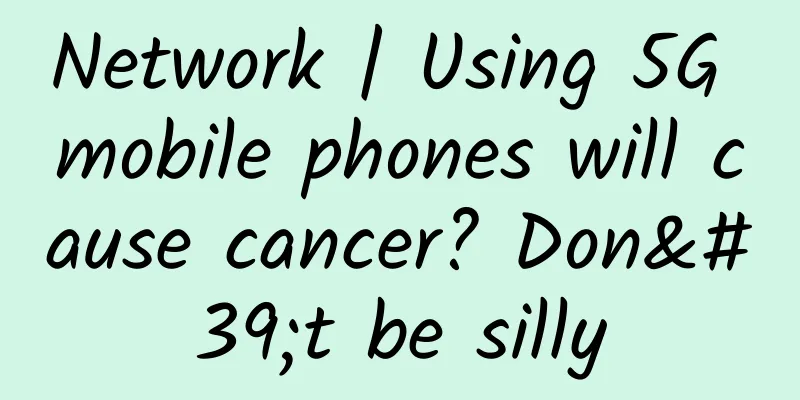Network | Using 5G mobile phones will cause cancer? Don't be silly

|
Whether wireless signals and mobile phone radiation will harm our health is a topic that has been talked about almost to death. Some time ago, Sohu Technology CEO Zhang Chaoyang expressed his views at a 5G conference, saying that the high density of 5G base stations, especially high-frequency bands like millimeter waves, are very harmful to the human body.
This statement sparked heated discussions among the public, and many people thought that he was "throwing cold water" on 5G. Perhaps under pressure from public opinion, he responded in a recent interview:
However, Zhang Chaoyang is not the only one who "doesn't quite understand". Does 5G, or even smartphone radiation, have any harm to the human body? Will it cause cancer? Until today, no one has been able to give an explanation that convinces everyone.
20 years ago, some people said that wireless networks were harmful to the human body. In the past few years, many research groups and well-known experts have issued various reports stating that the radio frequency radiation from smartphones does not affect physical health, but there are also many people who hold opposing views, and their views can be traced back to almost 20 years ago. The New York Times recently reported that as early as 2000, a physics PhD named Bill Curry published a report on the effects of wireless signals on the human body. At that time, a public school in Florida, USA was planning to lay a wireless Wi-Fi network and invited him to do relevant risk assessment and research. But Dr. Bill Curry gave a report that was contrary to the school's expectations. He believed that the high-frequency waves used by wireless Wi-Fi networks could "seriously endanger people's health" and even pose a risk of cancer. In this chart of "Microwave Absorption in Brain Tissue", we can see that as the frequency of radio waves increases, the radiation dose absorbed by the brain will gradually increase. Dr. Bill Curry also specifically marked the wireless frequency ranges of mobile phones, televisions, radios and other devices. The increase is very slow at first, but once the frequency exceeds 1GHz, the increase begins to accelerate, and by the 2.4GHz frequency range where Wi-Fi networks are located, it has almost shown a straight upward trend. For a time, the saying "the higher the wireless frequency, the greater the harm" began to spread widely among groups opposed to the development of wireless networks along with the research conclusion, and became a frequently cited scientific basis for this argument. ▲ Image from: Health Impact News In 2011, David Carpenter, dean of the State University of New York's College of Public Health, cited Dr. Bill Curry's report in a lawsuit seeking to force a public school to abandon wireless networks. It is said that this lawsuit was initiated by a parent who, like the ones we often see in the news, was worried that Internet radiation would harm his children's health. Now that 5G is coming, "whether mobile phone radiation is harmful to health" has once again become a new round of hot topic, even more so than in the 4G era. ▲ Image from: Daily Mail Why do we feel so scared when talking about 5G? In 2018, you may have seen the news that hundreds of birds mysteriously died near a 5G base station tower in the Netherlands. In fact, this was fabricated by a European anti-5G organization called "Stop5G" in the hope of making local people cautious about the deployment of 5G networks. The reasons they gave are the same as in the past, still emphasizing the hazards of electromagnetic waves, but compared to the medium and low frequencies used by 4G, since 5G has a higher frequency, it is more in line with Dr. Bill Curry’s previous conclusion that "high frequency = high hazard". Taking the Sub-6Ghz 5G specification promoted in China as an example, China Mobile will mainly use the 2.6GHz and 4.9GHz frequency bands, while China Unicom and China Telecom will share the 3.5GHz frequency band. All three are higher than the 700MHz-2.6GHz frequency band used by 4G before. But what is more worrying is the mmWave specification promoted in Europe and the United States, whose frequency has exceeded 24GHz. If the inference of the previous chart is correct, this high-frequency radio wave will undoubtedly further increase the risk of cancer. However, Christopher Collins, a professor of radiology at New York University, disagrees with this statement. He said that the "shielding effect" cannot be ignored when discussing the impact of electromagnetic waves on the human body. “Dr. Curry only studied the effects of electromagnetic waves on isolated tissues in the laboratory, but this does not mean that it will cause the same harm to the human body. He ignored some biological or medical common sense,” said Professor Collins. "Human skin itself can be considered a protective layer or barrier that blocks electromagnetic waves and protects our internal organs from the effects of radiation."
British physicist and cancer researcher David Grimes also believed in an interview with Wired that the claim that "5G causes cancer" is more like a repackaging of the previous question "Are wireless base stations and mobile phones harmful to humans?" This is just like when anti-vaccine activists see a new vaccine come out, they will bring out some previously overturned claims and criticize them again. At the same time, he said that linking electromagnetic waves with words like "radiation" would only increase the public's panic about new technologies:
We generally classify this harmful radiation as "ionizing radiation". This short wave will directly destroy the chemical bonds in human DNA, affect cells, and increase the probability of causing cancer. This is why we say that long-term exposure to the sun may cause skin cancer, and when you do an X-ray examination in the hospital, you can see a yellow triangular warning sign at the door of the examination room, because the ultraviolet rays and X-rays in the sun are both classified as ionizing radiation. Most mobile communication networks, Wi-Fi routers, airport security scanners, and mobile phone radio frequency signals are all in the "non-ionizing radiation" range. Their energy is not high enough, and their radiation levels are not enough to change cell structure. They are even far lower than the radiation effects of sunlight on the human body. In other words, even if you want to protect yourself from "non-ionizing radiation," you can't.
The fact that cell phone radiation can cause cancer has only been confirmed in experiments on mice. In order to answer the public's confusion, British telecom operator EE clearly pointed out in a 5G popular science article released this year that the base stations built by operators and the signal power transmitted will adopt the limits set by the ICNIRP organization. The latter is an independent international scientific organization that has established limits for non-ionizing radiation based on scientific literature results and relevant health risk assessments. Operator base stations and mobile phones connected to the network will adopt the limits established by ICNIRP, which has become the default standard in the communications industry. In fact, most experts and scholars can only give ambiguous words such as "maybe" and "perhaps" to the question of "whether mobile phone radiation can cause cancer in the human body", and cannot get a 100% answer. Several convincing cohort study reports did not conclude that mobile phone radiation increases the risk of brain cancer. Only one British study pointed out that the probability of developing acoustic neuroma was increased, but the researchers pointed out that this disease is so rare that even they themselves cannot be sure whether it is directly related to radiation.
At present, the most important research conclusion in the industry appeared in October 2018. According to the experimental report released by the US National Toxicology and Poisoning Administration, they have "clear evidence" that the radiation generated by smartphones will increase the probability of animals getting cancer. However, because the experimental subjects are mice and the experimental environment is under 2G/3G network, it cannot be directly compared to humans. The experiment lasted for two years. The researchers exposed 3,000 mice to electromagnetic radiation for up to 9 hours a day. The dosage was four times the normal human tolerance value. It is considered to be the most comprehensive study of its kind. Samet, the director of the International Agency for Research on Cancer under the World Health Organization, believes that the question of "the relationship between mobile phone radiation and cancer" needs to wait until the future to be answered:
It is worth noting that in 2014, the International Agency for Research on Cancer classified the electromagnetic waves from smartphones as substances that "may cause cancer" (Class 2B). The reason for this classification is that they could not obtain clear evidence from existing experiments. Under this 2B category, which states “may cause cancer,” there are other things that are either everyday or hard to prevent, such as pickled vegetables and gasoline engine exhaust. There's also titanium dioxide, a food additive often used in chewing gum. It seems that the radiation caused by mobile phones may be similar to that of chewing gum while walking on the street. |
<<: Apple releases the official version of iOS 12.4: brings multiple new features!
>>: Apple releases iOS 9.3.6 and iOS 10.3.4 updates for retired devices
Recommend
Unexpectedly, "burping and farting" can also affect carbon emissions
What are bull farts and why should we collect the...
This year was supposed to be a warm winter, so why is our country "the only coldest in the world"?
Recently, North China broke the historical low te...
Why does this fish have a "human face"? Watch it for three seconds and see who can hold back their laughter...
Without further ado, here are the pictures! Image...
Tesla was beaten by BYD, and its net profit fell by 44%. Musk rarely admitted his mistakes.
Tesla recently released its third-quarter financi...
Dongfeng Honda CR-V also learned from Volkswagen to "burn engine oil", and the official response seems to be a lie
Speaking of burning oil, Volkswagen owners must b...
Baoding has built 45 green belts to create a model city for "smart transportation" in the north
On December 12 , the Baoding Traffic Congestion Di...
How to detect dead links on a website? What tool can be used to check dead links?
For website SEO optimization workers, any neglige...
The secrets of Xigua Video’s recommendation mechanism revealed!
To understand the recommendation mechanism, we mu...
3 tips for user retention!
When we were doing research on user retention, we...
Why are mobile phones so expensive nowadays?
When we read information about mobile phones, we ...
Changhong gives TV a mobile "chip" Smart TV is no longer an "island" in the living room
Under the impact of PCs and smartphones, traditio...
Ping An Insurance e-marketing login: What is the difference between Baidu Search Resource Index 3.0 and Baidu Mini Program Index?
In the process of SEO, we often talk about the te...
A must-learn for founders and executives - Huawei Management Online Pre-Course
A must-learn for founders and executives - Huawei...
【2014】GitHub China Developer Annual Report
[[127178]] Produced by GitHuber.info team Preface...









